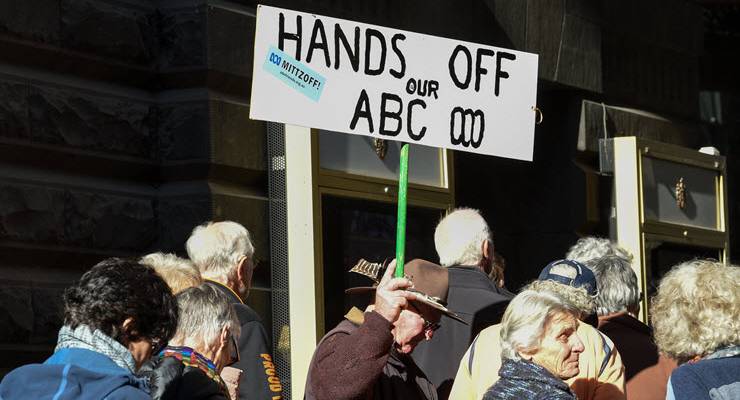
With two weeks to go, 2020 looks like a record year for journalism job losses. Up to 1000 newsroom jobs have disappeared in Australia — and about as many again in related media roles.
The result: widespread news deserts with about a third as many journalists reporting and editing news media as there were just 15 years ago. It looks like there are about 4000 now, compared to around 12,000 way back then.
In earlier big redundancy rounds, like 2008 and 2012, jobs were discarded through the thinning of journalist resources, closing ad-focussed supplements, and outsourcing and sharing copy and resources across mastheads (even with competitors).
Now, regions and local communities have been abandoned completely. Once ubiquitous suburban newspapers tossed over the picket fence have vanished from all but the wealthiest suburbs, leaving councils largely unreported. Regional mastheads have closed or shifted to a digital shadow of themselves.
The figures come in fits and starts. The ABC has told Senate estimates it shed 229 jobs as a result of federal government funding cuts. Its annual report says it spent $35.8 million on separation and redundancy costs.
News Corp doesn’t announce redundancy numbers (if it can help it), but the mid-year restructuring that axed its regional and suburban papers was estimated to cost about 500 jobs — at least half of them journalists. The company’s end-of-year financial reports to the US regulator says it spent about $120 million on “restructuring charges” for the News Media segment.
The last-minute rescue of the AAP newswire saved about two-thirds of the agency’s 150 jobs.
Many of the job losses go unreported. Contributors are quietly wound back. Journalists resign or retire and are not replaced. Small-scale rounds of up to 25 might rate a mention in the trade press.
For example, late last month, News Corp was flushed out by the journalists’ union, the Media, Entertainment and Arts Alliance, to confirm 25 further redundancies in its metropolitan tabloids. This included the 16 remaining photographers at The Courier-Mail who had survived the company’s 2017 70-person photographer purge.
This is a global trend. As Axios reported last week, 2020 also saw record newsroom jobs losses in the US — over 16,000, plus 14,000 in related media roles. That’s close to a third of the news media jobs that existed just a year ago.
Blame the disruption of the internet. Blame the attention wars. And, for a proximate cause, blame COVID-19. It’s accelerated the trend, compressing into six months events that would have taken perhaps another five years. That’s time lost that might have been spent finding solutions.
This rapid decline over 15 years has exhausted the industry. Back in December 2005 — before smartphones, before social media — The Sydney Morning Herald and The Age shed 55 jobs. It was presented as cost control, a light clip to remove a handful of high-wage employees.
It turned out to be distant thunder of a coming storm. Within three years, Fairfax was targeting 500 employees and barely a year has gone past since without both major companies — and plenty of smaller ones — reducing their headcount in desperation to keep bending the cost line below the falling income trend.
It’s sent a terrible message to readers. If the media doesn’t value journalism, why should you?
The good news is that we still have reporting that makes governments accountable — not least in the ABC. Remember: 2020 started with the brouhaha over AFP raids on the ABC and ended with the Brereton war crimes inquiry confirming the ABC’s reporting.
More diverse — often new, usually digital — voices are bringing different perspectives and reaching new audiences: The Guardian, The Saturday Paper, Junkee and, yes, Crikey. They use more diverse tools, including satire. Social media — for all its harm — has created space for long-excluded voices like Australia’s First Nations people to build their own media.
Issues that were once routinely ignored are more likely to break through too. Just these past few weeks, it’s been robodebt, cashless welfare, Me Too, Indigenous justice and climate change.
So, sure, news media has been disrupted — at enormous individual cost. But it’s time to ask: what happens now?








Yet somehow Chris Uhlmann retains his job.
I suspect that there is an inverse relationship between the numbers of average-paid workers (journalists) being sacked and the size of the boss’s salary? Often wondered how and when astronomical salaries for CEOs became the norm; I’m thinking it might have been when Capitalism adopted Thatcherism and the people believed the right-wing twaddle about Unions.
In the case of the SMH it was after Wokka destroyed it, a couple of equity funds dabbled and the gutted remnants had Greg Hywood, a shameless B grade tory stenographer, made editor and bought his first Maserati.
“The Guardian, The Saturday Paper, Junkee and, yes, Crikey. They use more diverse tools, including satire.”
And Friendly Jordies, apparently.
Well off well heeled unpaid interns of good economic family prospects breeding, could easily take up the slack of journalism as a vocation..On another hand, there’s umpteen u-tube blogging social media gigging opportunities to compete your wares with( that would be an irony, considering the decades long promotions of a neo-liberal gig economy, by corporate ‘free’ press MSM scribes n stenographers).
Journalism wasn’t killed, it was suicide.
This is well illustrated by the title MEAA – no notion that entertainment & the yartz did not have the same function.
The churnalism of rewriting PR handouts, toadying to the rich & powerful, exposing the principle of “speaking truth to power” as a joke, the monopoly control of the means of mass communication.
There were more journalists employed by government & bigbiz than newspapers by the 90s, long before the Intertube.
The choice of “government without newspapers or newspapers without government” died with with Max Headroom, probably the gasp of the belief that “If only the
Tzarpublic knew!” then righteousness would prevail.They don’t wish to know if it means a war on utes.